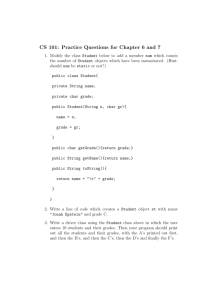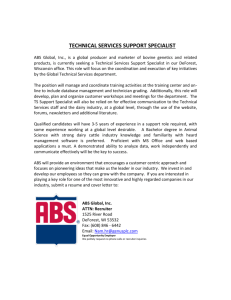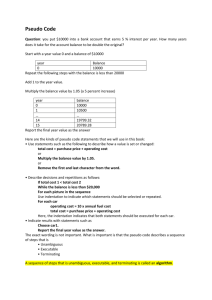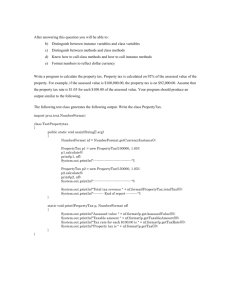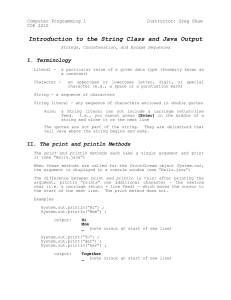Methods
advertisement
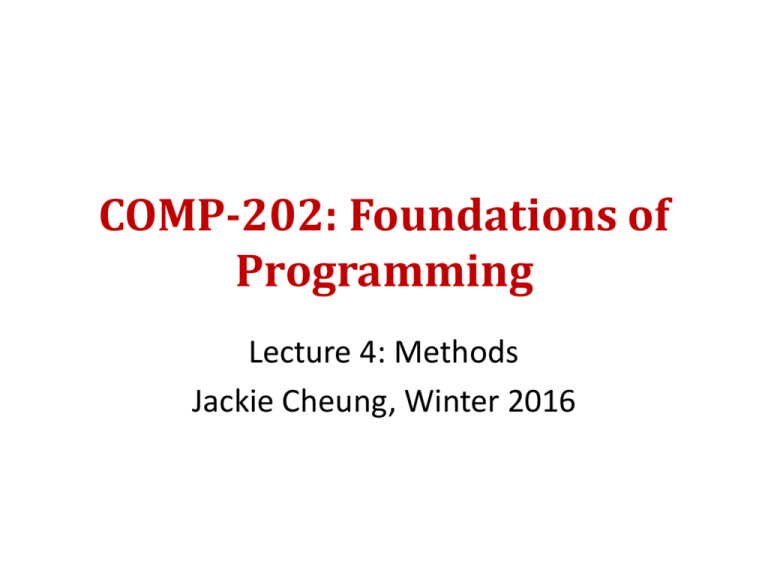
COMP-202: Foundations of
Programming
Lecture 4: Methods
Jackie Cheung, Winter 2016
Announcements
Quiz 1 postponed:
• Due Jan 26 at 11:59pm
Assignment 1 postponed:
• Due on Feb 1 at 11:59pm
2
Review
What is the difference between an int and a
double?
What is the difference between byte, shorts,
ints, and longs?
What is the different between a char and a
String?
3
This Lecture
Methods
• Methods we’ve seen so far
• Using existing Python methods (e.g., String,
Math)
• Defining our own methods
4
Methods
We’ve been calling certain segments of code
methods.
public class HelloWorld {
public static void main(String[] args) {
System.out.println("Hello, World!");
}
}
5
Calling Methods
We call a method in order to execute the code
contained in the method definition.
Some examples?
• Every time you run a program, you are calling the
main method of some class of the program.
• System.out.println(<expr>) is a method call!
• Math.ceil(<num>) is a method call!
• Math.log(<num>) is a method call!
6
Purposes of Methods
Some methods map an input value to an output
value.
e.g., Math.ceil(double a) implements
𝑓(𝑥) = 𝑥 .
Others simply perform some useful action.
e.g., System.out.println()prints a new line.
Still others do both of the above (return a value
AND perform other actions).
7
Using Java Libraries
The JDK comes with many libraries, which
contain classes and methods for you to use.
•
•
•
•
String library
Math library
Swing library (used for graphics)
Libraries for networking
8
Math Library
Contains useful and common methods you can
use off-the-shelf (i.e., don't have to write
yourself)
Also, constants like E or PI
How do you access them?
9
Documentation
Read the Application Programming Interface
(API) for the specification of a library.
e.g., Math library:
http://docs.oracle.com/javase/7/docs/api/java/lang
/Math.html
What information do you get from an API?
10
Sample Entry
static double
abs(double a)
Returns the absolute value of
a double value.
Name of the method
11
Sample Entry
static double
abs(double a)
Returns the absolute value of
a double value.
The number and type
of input arguments
The name of the method together with the
number and type of input arguments is
called the signature of the method.
12
Sample Entry
static double
abs(double a)
Returns the absolute value of
a double value.
Description of what the
method does.
13
Sample Entry
static double
abs(double a)
Returns the absolute value of
a double value.
The return type of the method
14
Sample Entry
static double
abs(double a)
Returns the absolute value of
a double value.
This keyword means this method does
not have to be called on a particular
object. Don't worry too much about it
for now.
15
Sample Entry
static double
abs(double a)
Returns the absolute value of
a double value.
Based on this API entry, we know that we
call use this method with something like:
Math.abs(-4.0)
and that this expression evaluates into the
value 4.0 with type double.
16
Sample Entry
static double
abs(double a)
Returns the absolute value of
a double value.
We also know that
Math.abs("5.0")
would result in an error.
17
Questions
Give the input arguments (with types), and
return types of the following Math library
methods, and describe what they do.
Math.pow
Math.random
Math.max
18
void Methods
The return type can be void; i.e., these methods
do not return a value.
The purpose is to have side effects, not to
compute a value directly.
• Note irony of term—side effects are intentional!
• e.g., System.out.println()
19
Question
Why doesn’t this make sense?
String a = System.out.println("hi");
20
Writing Your Own Methods
You can define your own methods!
Motivation:
• Suppose I want to compute the log2 function
from last class, at multiple points in my program.
• I don't want to copy and paste the code into each
point where I need it!
• Instead, I write the method once, which I call
log2ceil(double x), and call it whenever I
need to.
21
Adding to Our Toolbox
Analogy: writing a new method is like adding to
our toolbox for something we do often.
22
How To Write A Method
public static double log2ceil(double x) {
// compute f(x) = ceil(log2(x))
double result = Math.log(x) / Math.log(2.0);
return Math.ceil(result);
}
Keywords,
return type of double
Method signature, just
like in the API
Curly braces to define method body
23
General Form
Parts:
1.
2.
3.
4.
Keywords (e.g., public static)
Return type (e.g., void, int, double)
Name of method (e.g., log2ceil)
Parentheses containing arguments with types
(e.g., double)
5. Body of the method (what it actually does)
Include return statement if return type is not void
24
Methods That Return Values
What would the method definition look like for
a method that computes the area of a circle?
public static double computeAreaCircle(double r)
What would the method definition look like for
a method that compares two Strings and checks
if one is the reverse of another?
public static boolean checkIfReversed(String s1,
String s2)
25
Using Methods That Return Values
Since these methods return values (and may
also have side effects), we can use the result as
part of expressions.
// sum areas of two circles
double sumArea = computeAreaCircle(5.0) +
computeAreaCircle(4.0);
26
How To Return Values
return <expression>;
e.g., A pretty useless method:
public static int identity(int a) {
return a; // just return a itself
}
The expression returned must match what is
expected in the header of the method.
Execution returns immediately to where the
method was called.
27
return Statement
public static double foo(double a) {
return a * 2;
return a * 3;
}
Second return statement is unreachable.
28
Printing vs. Returning
Be careful of the difference:
Write a method that prints the sum of three
doubles
Write a method that returns the sum of three
doubles
What would be the return type of the two
methods?
29
Tracing the Code
Let’s use our newly defined method multiple
times, and trace the execution of the code!
30
Trace this Code
public class TraceLog2 {
public static void main(String[] args) {
System.out.println(log2ceil(3.0));
System.out.println(log2ceil(6.0));
System.out.println(log2ceil(9.0));
}
public static double log2ceil(double x) {
// compute f(x) = ceil(log2(x))
double result = Math.log(x) / Math.log(2.0);
return Math.ceil(result);
}
}
31
Example: computeAreaCircle
Fill in the method body of computeAreaCircle
Let's do this together.
32
Exercise
Write a method called sayGreeting():
it takes two Strings as input,
the first represents the speaker,
the second represents the listener,
it prints a String saying the speaker saying
something to the listener, like "<Speaker> says hello
to <Listener>"
33
Methods Calling Methods
Methods can call other methods.
e.g., Let’s implement a method that returns the
volume of a sphere given its radius, and implement
our own cube method!
34
Exercise: Die Roll
Write a method that returns a double, which is
one of 1.0, 2.0, 3.0, 4.0, 5.0, or 6.0, each
selected with equal probability. This
corresponds to rolling a six-sided die.
• What is the return type?
• What is the list of arguments?
• Test your method by calling it in the main
method.
• Use methods in the Math library to help you.
35
